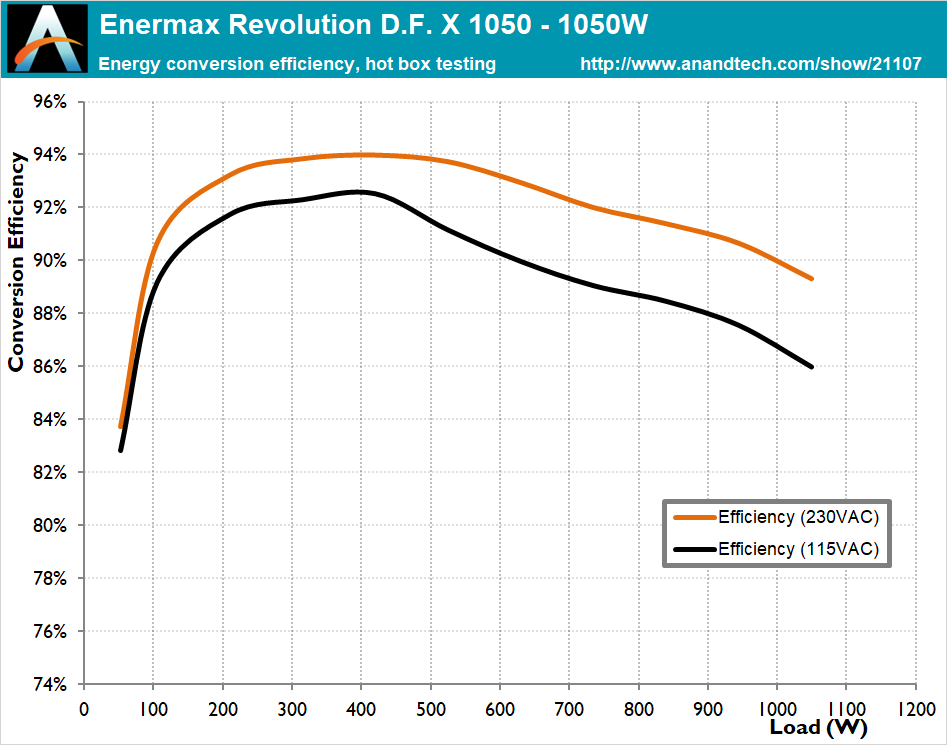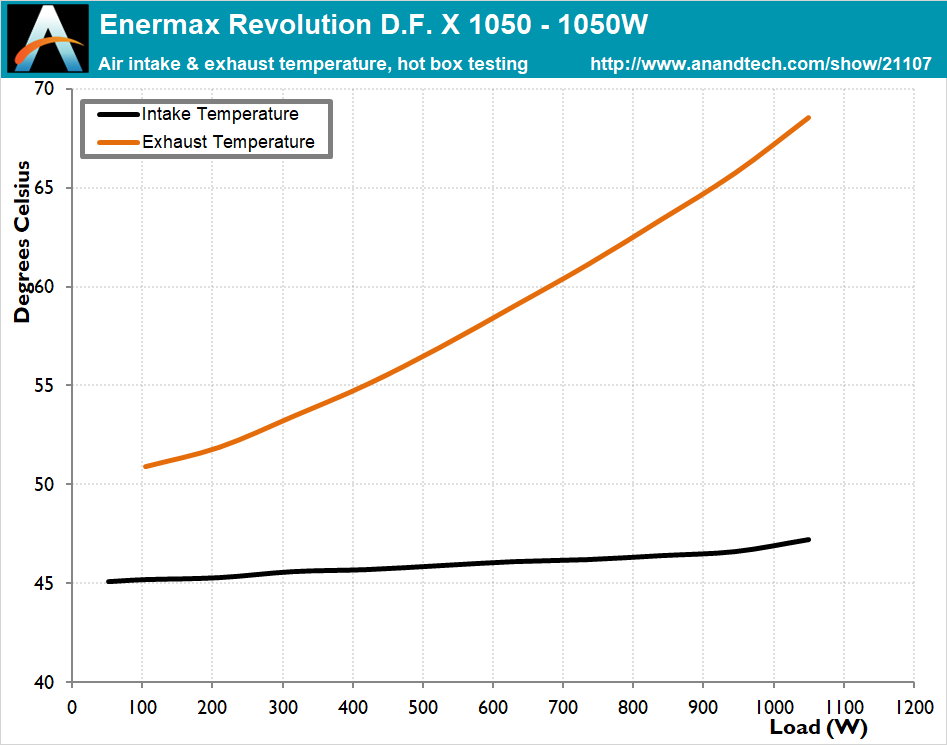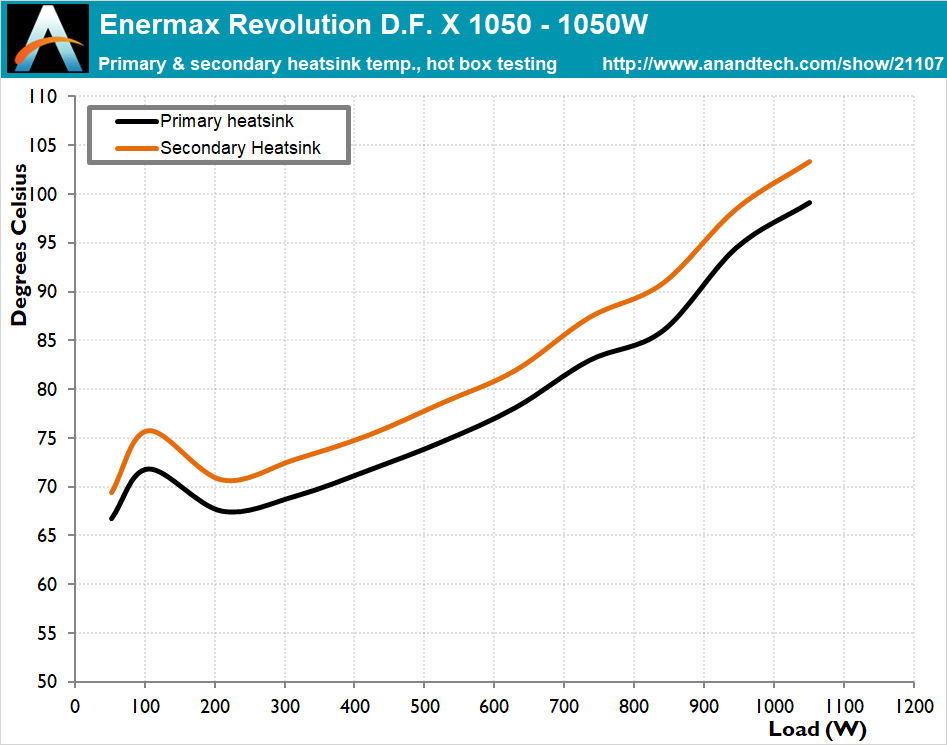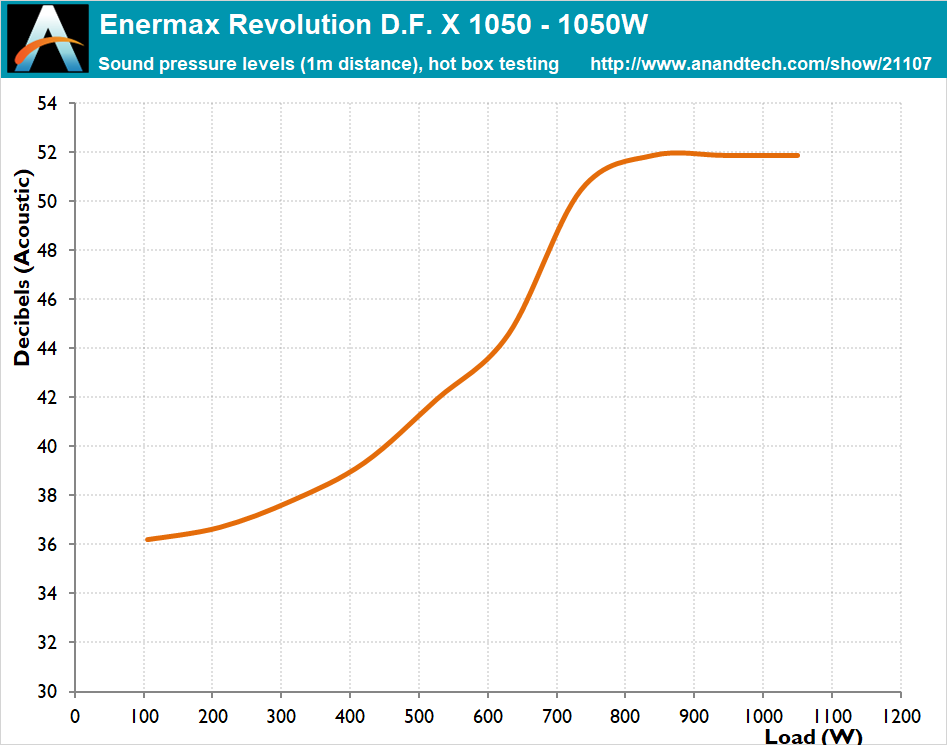The Enermax Revolution D.F. X 1050W PSU Review: High Power, Highly Reliable
by E. Fylladitakis on November 9, 2023 8:00 AM EST- Posted in
- Cases/Cooling/PSUs
- PSUs
- 80Plus Gold
- Enermax
- ATX v3.0
- 12VHPWR
- SANR
Hot Test Results (~45°C Ambient Temperature)
The Enermax Revolution D.F. X 1050 has its output specified for an ambient temperature of 40°C. Generally, PC power supply units (PSUs) are categorized based on their temperature ratings, with 40°C typically associated with low-end to entry-level mainstream units, and 50°C designated for quality mid-tier to high-performance products. The 40°C rating of the Enermax Revolution D.F. X 1050 is disquieting for a product of such a class but the rating alone does not warrant poor high temperature performance.
The performance of PC power supply units (PSUs) is known to vary with ambient temperature, with the degree of variation largely dependent on the design and quality of the unit. In the case of the Enermax Revolution D.F. X 1050 PSU, the energy conversion efficiency exhibits a marginal drop of 0.3-0.4% at low loads, a range that is within acceptable limits. However, as the load increases, the efficiency decrement escalates to higher than 1%, indicating a different efficiency behavior under heavy load conditions compared to low load scenarios. This pattern suggests that the thermal stress on the active components becomes more pronounced as the unit is subjected to higher loads, reflecting on the design characteristics of the Enermax Revolution D.F. X 1050.
Under adverse environmental conditions, the fan within the Enermax Revolution D.F. X 1050 PSU begins its operation almost immediately after the load surpasses 50 Watts. The fan's activity progressively escalates, reaching its apex once the load surpasses 800 Watts. Beyond this point, the temperatures tend to elevate to a somewhat uncomfortable level, indicating a threshold at the platform’s design capacity and capabilities.















17 Comments
View All Comments
evanh - Monday, November 13, 2023 - link
The female pins are a new design. That's the most important change.The adjusted pin length is just a minor tweak, not important in any way.
E.Fyll - Monday, November 13, 2023 - link
The female - and male - pins are entirely the same.I have no idea where you picked up that nonsense, probably from some clickbait article of shorts, but, once again, the only difference is the length of the Sense pins and that is only taking place on the equipment's side too. You can read the specifications, they are publicly available. You should not be spreading misinformation.
evanh - Monday, November 13, 2023 - link
I don't know why you'd think those power pins are the same. The whole purpose of the 12V-2x6 plug even existing is to fix the overheating flawed design of the 12VHPWR plug. Having a couple of shorter signal pins ain't gonna make the slightest difference to fixing it.MamiyaOtaru - Tuesday, November 14, 2023 - link
you're sort of right. It' not really fixed. But the shorter signal pins do help ensure it is inserted all the way before it runs current. Still has deeper flaws thoughevanh - Wednesday, November 15, 2023 - link
Yes, 12VHPWR plug has deeper flaws - weak female power pins in the plug. And that is what is really being fixed with the introduction of the replacement 12V-2x6 plug.12VHPWR cables, both supplied with PSU and as adaptors, need to all be recalled and replaced with the newly introduced 12V-2x6 cables. All manufactures should be doing this immediately to stop the on-going damage to graphics cards.
Threska - Thursday, November 9, 2023 - link
"Ball-bearing engines are very reliable but not the quietest, however the PSU features a semi-passive design that will completely stop the fan while the load is low. "Doesn't look vibration isolated from chassis.
Samus - Thursday, November 9, 2023 - link
For the price it's hard to argue with these results, but I can't help but think, realistically, this should be considered an 800-watt PSU. It's capable of 1050w but it's operational sweet spot and efficiency are more in-line with 750-800w units, where continuous current will never exceed 80% load, or 600-650w. Since load is really inconsistent during most use cases (gaming, burst performance, etc) it's good to have the overhead and potential for 1000w+ but if you have a system design that often hovers around 650w load (like an RTX 4080 + i7-13700k) this is among the best candidates out there.